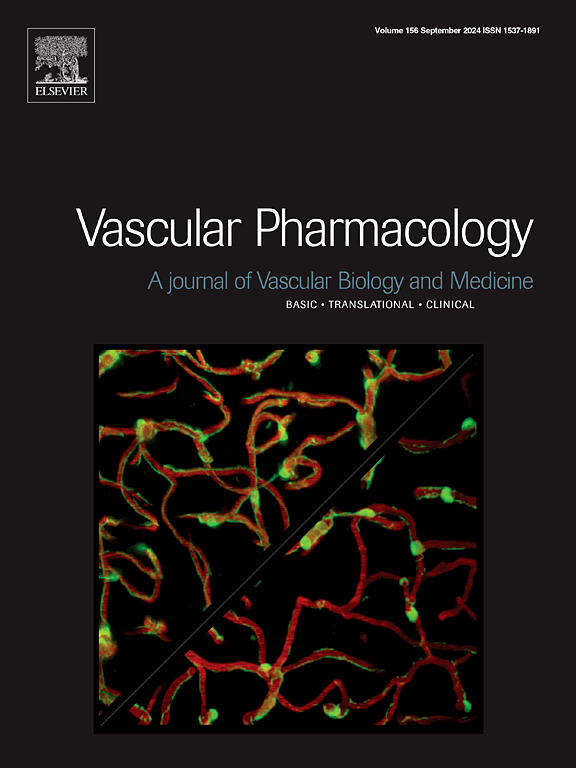The lncRNA DSCR9 is modulated in pulmonary arterial hypertension endothelial cell models and is associated with alterations in the nitric oxide pathway
IF 3.5
3区 医学
Q2 PHARMACOLOGY & PHARMACY
引用次数: 0
Abstract
Long non-coding RNA (lncRNA) may be involved in dysfunction of pulmonary artery endothelial cells (PAEC) and, thus, in pulmonary arterial hypertension (PAH) pathobiology.
We screened the RNA expression profile of commercial human PAEC (hPAEC) exposed to increased hydrostatic pressure, and found that the lncRNA Down syndrome critical region 9 (DSCR9) was the most regulated transcript (log2FC 1.89 vs control). We confirmed by RT-qPCR that DSCR9 levels were higher in PAEC isolated from patients with idiopathic PAH (iPAH-PAEC), as well as in induced pluripotent stem cell-derived endothelial cells (iPSC-EC) from a patient with BMPR2-mutated PAH, than in relevant controls. Moreover, a re-analysis of the publicly available GSE117261 microarray dataset revealed that DSCR9 was upregulated in the lung tissue of PAH patients. In silico simulation indicated that DSCR9 would be mainly located in the nucleus and could interact with calcium/calmodulin-dependent protein kinase II beta (CAMK2B) and nitric oxide synthase 3 (NOS3, encoding eNOS). CAMK2B levels resulted 3.4-fold higher (p < 0.05) in iPAH-PAEC transfected with a DSCR9-GFP carrying plasmid than with a GFP-only-carrying one. A trend for higher NOS3 expression was also noted. GFP immunostaining was predominantly nuclear and cytoplasmic upon DSCR9-GFP or GFP-only transfection, respectively. CAMK2B and NOS3 mRNA were also higher in iPAH-PAEC than control-PAEC in basal conditions. Instead, variations in total and phosphorylated CAMK2B, eNOS, and NO synthesis were inconsistent. We conclude that DSCR9 is upregulated in PAH-related endothelial cell models and influences CAMK2B and NOS3 expression. Future studies are necessary to determine whether DSCR9 affects NO availability, including in PAH.

lncRNA DSCR9在肺动脉高压内皮细胞模型中被调节,并与一氧化氮通路的改变有关。
长链非编码RNA (lncRNA)可能参与肺动脉内皮细胞(PAEC)功能障碍,从而参与肺动脉高压(PAH)的病理生物学。我们筛选了暴露于静水压力增加的商业人类PAEC (hPAEC)的RNA表达谱,发现lncRNA唐氏综合征关键区9 (DSCR9)是最受调控的转录物(log2FC 1.89 vs对照组)。我们通过RT-qPCR证实,从特发性PAH患者分离的PAEC (iPAH-PAEC)以及从bmpr2突变的PAH患者分离的诱导多能干细胞来源的内皮细胞(iPSC-EC)中,DSCR9水平高于相关对照。此外,对公开可用的GSE117261微阵列数据集的重新分析显示,DSCR9在PAH患者的肺组织中上调。硅模拟表明,DSCR9主要位于细胞核内,可与钙/钙调素依赖性蛋白激酶II β (CAMK2B)和编码eNOS的一氧化氮合酶3 (NOS3)相互作用。CAMK2B水平升高3.4倍(p
本文章由计算机程序翻译,如有差异,请以英文原文为准。
求助全文
约1分钟内获得全文
求助全文
来源期刊

Vascular pharmacology
医学-药学
CiteScore
6.60
自引率
2.50%
发文量
153
审稿时长
31 days
期刊介绍:
Vascular Pharmacology publishes papers, which contains results of all aspects of biology and pharmacology of the vascular system.
Papers are encouraged in basic, translational and clinical aspects of Vascular Biology and Pharmacology, utilizing approaches ranging from molecular biology to integrative physiology. All papers are in English.
The Journal publishes review articles which include vascular aspects of thrombosis, inflammation, cell signalling, atherosclerosis, and lipid metabolism.
 求助内容:
求助内容: 应助结果提醒方式:
应助结果提醒方式:


